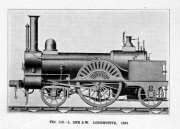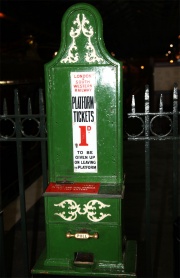Difference between revisions of "London and South Western Railway"
| (31 intermediate revisions by 5 users not shown) | |||
| Line 1: | Line 1: | ||
[[Image:Im1925EnV139-p424.jpg|thumb| 1855. [[Joseph Hamilton Beattie]] Type Crescent.]] | |||
[[Image:Im1880EnV50-p183.jpg |thumb| 1880. ]] | [[Image:Im1880EnV50-p183.jpg |thumb| 1880. ]] | ||
[[Image:Im1925EnV140-p055a.jpg|thumb| 1880. [[William Adams]] engine. ]] | |||
[[Image:Im1925EnV140-p286.jpg|thumb| 1882-5. ]] | |||
[[image:Im1889EnV67-p68a.jpg|thumb| 1889.]] | [[image:Im1889EnV67-p68a.jpg|thumb| 1889.]] | ||
[[Image:Im1925EnV140-p366a.jpg|thumb| 1892-3. ]] | |||
[[Image:Im090619SR-LSWR-157b.jpg|thumb| 1893. Express Passenger Engine No. 563 built at Nine Elms. Exhibit at the [[Shildon Locomotion Museum]]. ]] | [[Image:Im090619SR-LSWR-157b.jpg|thumb| 1893. Express Passenger Engine No. 563 built at Nine Elms. Exhibit at the [[Shildon Locomotion Museum]]. ]] | ||
[[image:Im1923EnV135-p280.jpg|thumb| Atalanta with Beatties early condensing apparatus.]][[image:Im1895EnV79-p246a.jpg|thumb| 1895.]] | |||
[[Image:Im1894OurRail2-Pullman.jpg|thumb| Pullman car interior. Picture published in 1894. ]] | [[Image:Im1894OurRail2-Pullman.jpg|thumb| Pullman car interior. Picture published in 1894. ]] | ||
[[Image:Im1894OurRail2-Pullman2.jpg|thumb| Pullman car exterior. Picture published in 1894. ]] | [[Image:Im1894OurRail2-Pullman2.jpg|thumb| Pullman car exterior. Picture published in 1894. ]] | ||
| Line 13: | Line 18: | ||
[[Image:Im1901Eing-LSWR1.jpg|thumb| 1901. ]] | [[Image:Im1901Eing-LSWR1.jpg|thumb| 1901. ]] | ||
[[Image:Im1901Eing-LSWR2.jpg|thumb| 1901. ]] | [[Image:Im1901Eing-LSWR2.jpg|thumb| 1901. ]] | ||
[[image:Im1963EnV216-p147a.jpg |thumb| 1903. No. 1.]] | |||
[[image:Im1963EnV216-p147b.jpg |thumb| 1903. No. 1.]] | |||
[[Image:Im1903EnV96-p011.jpg|thumb| 1903. Four coupled express Locomotive.]] | [[Image:Im1903EnV96-p011.jpg|thumb| 1903. Four coupled express Locomotive.]] | ||
[[Image:Im1903EnV96-p011b.jpg|thumb| 1903. Crank shaft.]] | [[Image:Im1903EnV96-p011b.jpg|thumb| 1903. Crank shaft.]] | ||
[[Image:Im1904AH-LSW.jpg|thumb| 1904.]] | |||
[[image:Im1963EnV216-p147c.jpg |thumb| 1904. No. 2 built at Nine Elms.]] | |||
[[Image:Im1905V100-p386aa.jpg |thumb|Southampton Dock in May 1903. 1905. ]] | [[Image:Im1905V100-p386aa.jpg |thumb|Southampton Dock in May 1903. 1905. ]] | ||
[[Image:Im1905V100-p386ab.jpg |thumb|Southampton Docks in October 1903. 1905. ]] | [[Image:Im1905V100-p386ab.jpg |thumb|Southampton Docks in October 1903. 1905. ]] | ||
[[Image:Im1905V100-p386ba.jpg |thumb|Southampton Docks. View taken in May 1903. 1905. ]] | [[Image:Im1905V100-p386ba.jpg |thumb|Southampton Docks. View taken in May 1903. 1905. ]] | ||
[[Image:Im1905V100-p386bb.jpg |thumb|Southampton Docks. Progress of Wall in February 1904. 1905. ]] | [[Image:Im1905V100-p386bb.jpg |thumb|Southampton Docks. Progress of Wall in February 1904. 1905. ]] | ||
[[image:Im1963EnV216-p147d.jpg |thumb| 1905. No. 5 built at Nine Elms.]] | |||
[[image:Im1906EnV102-p424j.jpg|thumb| 1906.]] | [[image:Im1906EnV102-p424j.jpg|thumb| 1906.]] | ||
[[Image:Im1906EnV102-p018a.jpg |thumb| 1906 . ]] | |||
[[image:Im1908aEng-LSWR.jpg|thumb| 1908. ]] | [[image:Im1908aEng-LSWR.jpg|thumb| 1908. ]] | ||
[[image:Im1908aEng-LSWR1.jpg|thumb| 1908. ]] | [[image:Im1908aEng-LSWR1.jpg|thumb| 1908. ]] | ||
[[image:Im19080715Loco-LSW.jpg|thumb| July 1908. ]] | [[image:Im19080715Loco-LSW.jpg|thumb| July 1908. ]] | ||
[[Image:Im1911BORC-p013.jpg |thumb|1911.Train Service Easter Monday 17th of April. [[Brooklands Official Race Card. April 17th 1911|Brooklands Race Meeting]].]] | |||
[[image:Im191108RlyM-LSWR.jpg|thumb| August 1911. ]] | [[image:Im191108RlyM-LSWR.jpg|thumb| August 1911. ]] | ||
[[Image:Im1913Eing-L&SWR0.jpg|thumb| 1913. ]] | [[Image:Im1913Eing-L&SWR0.jpg|thumb| 1913. ]] | ||
[[Image:ImTivMus-LSWR.jpg|thumb|]] | [[Image:ImTivMus-LSWR.jpg|thumb|]] | ||
[[Image:Im1914EnV117-p105.jpg|thumb| 1914. ]] | |||
[[Image:Im1915EnV119-p014bb.jpg|thumb| 1915. ]] | |||
[[image:Im191705RlyM-LSWR.jpg|thumb| May 1917. ]] | [[image:Im191705RlyM-LSWR.jpg|thumb| May 1917. ]] | ||
[[image:Im191801RlyM-LSWR.jpg|thumb| January 1918. ]] | [[image:Im191801RlyM-LSWR.jpg|thumb| January 1918. ]] | ||
[[image:Im1921EnV132-p118.jpg|thumb| 1921. Trains for the Bournemouth Service by S. Warner, and engineer from Eastleigh.]] | |||
[[image:Im1922EnV133-p028cc.jpg|thumb| 1921.]] | |||
[[Image:Im1925EnV139-p425a.jpg|thumb| 1925. ]] | |||
[[image:Im1957v203-p483a.jpg |thumb| 1957. ]] | |||
[[image:Im1964EnV218-p964a.jpg |thumb| 1964.]] | |||
LSWR of [[Waterloo Railway Station]], London | LSWR of [[Waterloo Railway Station]], London | ||
| Line 41: | Line 60: | ||
In 1840 the 76.75 mile line ran from Vauxhall, London to Southampton with stations at Wandsworth, Wimbledon, Kingston, Esher and Hampton Court, Walton, Weybridge, Woking, Farnborough, Winchfield, Basingstoke, Andover Road and Winchester. Fares for the full one-way journey ranged from 20s in first-class to 7s in 3rd in the Goods train. <ref>Bradshaw’s Railway Companion 1840</ref> | In 1840 the 76.75 mile line ran from Vauxhall, London to Southampton with stations at Wandsworth, Wimbledon, Kingston, Esher and Hampton Court, Walton, Weybridge, Woking, Farnborough, Winchfield, Basingstoke, Andover Road and Winchester. Fares for the full one-way journey ranged from 20s in first-class to 7s in 3rd in the Goods train. <ref>Bradshaw’s Railway Companion 1840</ref> | ||
1848 [[Waterloo Railway Station]] opened. <ref>The Engineer 1922/03/24</ref> | |||
1862 [[William Robert Galbraith|W. R. Galbraith]] was appointed engineer of '''The London and South Western Railway''' with [[Julian Horn Tolme]], succeeding [[John Edward Errington]].<ref>The Engineer 1862/08/22</ref> | |||
1888 See [[Locomotive Stock June 1888]] | 1888 See [[Locomotive Stock June 1888]] | ||
| Line 46: | Line 69: | ||
1892 The company absorbed the [[Southampton Dock Co]]. | 1892 The company absorbed the [[Southampton Dock Co]]. | ||
1908 The company owns 857 miles of road, and partly with others, 23 miles more. <ref>The Stock Exchange Year Book 1908</ref> | 1908 The company owns 857 miles of road (track), and partly with others, 23 miles more. <ref>The Stock Exchange Year Book 1908</ref> | ||
1912 Adopted a proposal for a 47 mile third rail DC electrification from Waterloo to the Hampton Court and Shepperton branches and the Kingston and Hounslow loops with power supplied from a purpose built power station at Wimbledon. 84 three coach electric units were converted from former steam hauled suburban sets. Each motor coach was powered by two 275 hp [[Metropolitan-Vickers]] traction motors. In addition an all-electric relay multiple unit system was supplied by [[Metropolitan-Vickers]] for operation of longer trains under the control of a single driver. These trains set the standard for what later became the Southern Electric. The Waterloo to Wimbledon service via East Putney commenced electric operation in 1915 with the Shepperton and Hampton Court routes completed the following year. | |||
1923 As a result of the grouping in 1923, the L&SWR lines became part of the [[Southern Railway]]. | |||
Among the most significant achievements of the L&SWR were the electrification of suburban lines, the introduction of power signalling, the development of Southampton Docks, the rebuilding of Waterloo Station as one of the great stations of the world and the handling of the massive traffic involved in the First World War. | Among the most significant achievements of the L&SWR were the electrification of suburban lines, the introduction of power signalling, the development of Southampton Docks, the rebuilding of Waterloo Station as one of the great stations of the world and the handling of the massive traffic involved in the First World War. | ||
==Locomotive Engineers== | |||
The LSWR locomotive engineers were: | |||
* [[John Viret Gooch]] 1841-1850 | |||
* [[Joseph Hamilton Beattie]] 1850-1871 | |||
* [[William George Beattie]] 1871-1877 | |||
* [[William Adams]] 1877-1895 | |||
* [[Dugald Drummond]] 1895-1912 | |||
* [[Robert Wallace Urie]] 1912-1923 | |||
The major locomotive classes of Robert Urie were continued and further developed by his successor on the [[Southern Railway]], [[Richard Maunsell]]. | |||
The LSWR's General Manager Sir [[Herbert Ashcombe Walker]] became the Manager of the [[Southern Railway]]; Walker himself was succeeded in the latter post by Major [[Gilbert Szlumper]], formerly his assistant on the L&SWR. | |||
Revision as of 09:12, 17 December 2018







LSWR of Waterloo Railway Station, London
1834 The company was incorporated as the London and Southampton Railway.
1839 The name was changed to the London and South Western Railway.
Its ultimate network extended from London to Plymouth via Yeovil, Exeter and Okehampton with branches to Barnstaple, Ilfracombe and Torrington and Padstow and Wadebridge — a territory in which it was in direct competition with the Great Western Railway — and, via Basingstoke, Winchester and Southampton, along the Dorset coast to Bournemouth and Weymouth.
It also had a large number of branches which connected to places such as Portsmouth and Reading, and some joint railway operations with others — including the Somerset and Dorset Joint Railway.
In 1840 the 76.75 mile line ran from Vauxhall, London to Southampton with stations at Wandsworth, Wimbledon, Kingston, Esher and Hampton Court, Walton, Weybridge, Woking, Farnborough, Winchfield, Basingstoke, Andover Road and Winchester. Fares for the full one-way journey ranged from 20s in first-class to 7s in 3rd in the Goods train. [1]
1848 Waterloo Railway Station opened. [2]
1862 W. R. Galbraith was appointed engineer of The London and South Western Railway with Julian Horn Tolme, succeeding John Edward Errington.[3]
1888 See Locomotive Stock June 1888
1892 The company absorbed the Southampton Dock Co.
1908 The company owns 857 miles of road (track), and partly with others, 23 miles more. [4]
1912 Adopted a proposal for a 47 mile third rail DC electrification from Waterloo to the Hampton Court and Shepperton branches and the Kingston and Hounslow loops with power supplied from a purpose built power station at Wimbledon. 84 three coach electric units were converted from former steam hauled suburban sets. Each motor coach was powered by two 275 hp Metropolitan-Vickers traction motors. In addition an all-electric relay multiple unit system was supplied by Metropolitan-Vickers for operation of longer trains under the control of a single driver. These trains set the standard for what later became the Southern Electric. The Waterloo to Wimbledon service via East Putney commenced electric operation in 1915 with the Shepperton and Hampton Court routes completed the following year.
1923 As a result of the grouping in 1923, the L&SWR lines became part of the Southern Railway.
Among the most significant achievements of the L&SWR were the electrification of suburban lines, the introduction of power signalling, the development of Southampton Docks, the rebuilding of Waterloo Station as one of the great stations of the world and the handling of the massive traffic involved in the First World War.
Locomotive Engineers
The LSWR locomotive engineers were:
- John Viret Gooch 1841-1850
- Joseph Hamilton Beattie 1850-1871
- William George Beattie 1871-1877
- William Adams 1877-1895
- Dugald Drummond 1895-1912
- Robert Wallace Urie 1912-1923
The major locomotive classes of Robert Urie were continued and further developed by his successor on the Southern Railway, Richard Maunsell.
The LSWR's General Manager Sir Herbert Ashcombe Walker became the Manager of the Southern Railway; Walker himself was succeeded in the latter post by Major Gilbert Szlumper, formerly his assistant on the L&SWR.










































